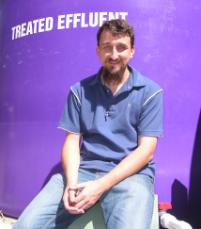Ben pipes up to ensure Woodford Festival is 'flushed' with success
Published on 27 November, 2009
Ben Kele and his band of students hope no-one notices their performance during the Woodford Folk Festival.
They are directing a massive conga line of human waste, as the amount of effluent through the sewerage system suddenly peaks at 1 megalitre per day.
Luckily for all concerned, Ben has masterminded an 11-stage multi-barrier sewerage system with help from $1.2 million from the festival. [He's also helped install 800m of new sewerage pipes and a new $80,000 treatment system to remove tannin colour from the drinking water].
Previously, the festival has relied on a fleet of trucks to remove effluent in between each event, costing 11% of the carbon budget.
Ben is a PhD researcher and sewerage system contractor who has not only co-opted environmental engineering students but also his mum (camp cook) and father (site manager) to work alongside local tradesmen for 4 months of preparation works.
"I feel a bit guilty since the students have been camping out on site ... but then I've been staying there too," he said.
From Christmas day when campers arrive and for the rest of the week, the new system starts with sieves channelled into large tanks which can "hold a festival worth of solids". The solids can be removed after the show or, if Ben has his way, can be used to run a biogas generator connected to the electricity grid.
The remaining liquid effluent then goes through a series of aeration stages to reduce faecal coliforms and pathogens. Then the volcanic rock filters absorb nasty chemicals (including endocrine disruptors) as well as smells and colours.
The hydrogen peroxide dosing unit disinfects and enhances the biodegradation of organic matter, mimicking and expediting the natural process without creating harmful byproducts.
Fine-sand filtration follows and then the waste goes into granulated activated carbon filters to remove any remaining organic material plus more colour, odour and nutrients.
Finally, after some ultraviolet disinfection, the water ends up in constructed wetlands, ready for harvesting for nursery operations and revegetation, thus reducing the demands on the site's drinkable water stores.
Ben is confident the system's performance will be up to scratch because "we hit it with so many treatments that there is no room for failure".


